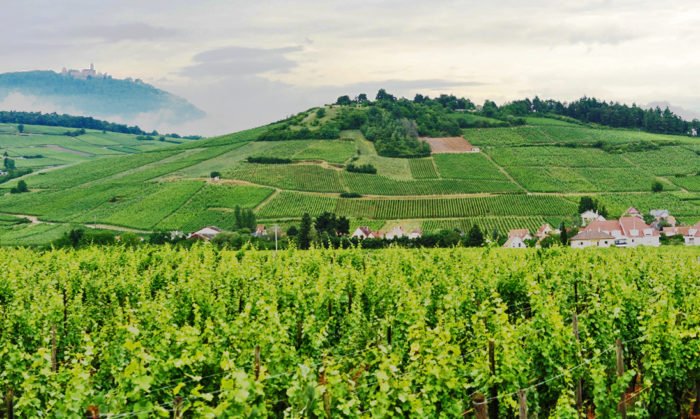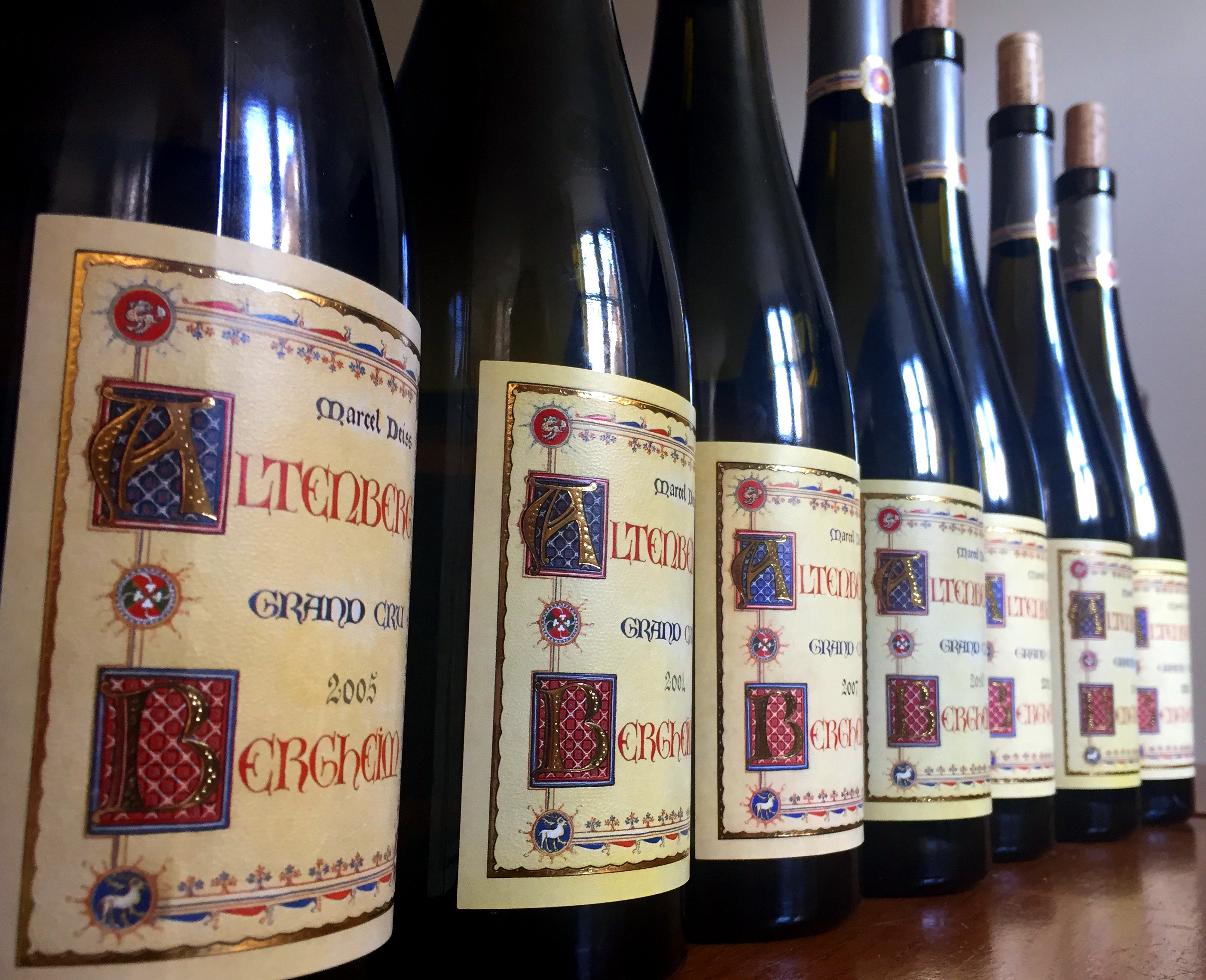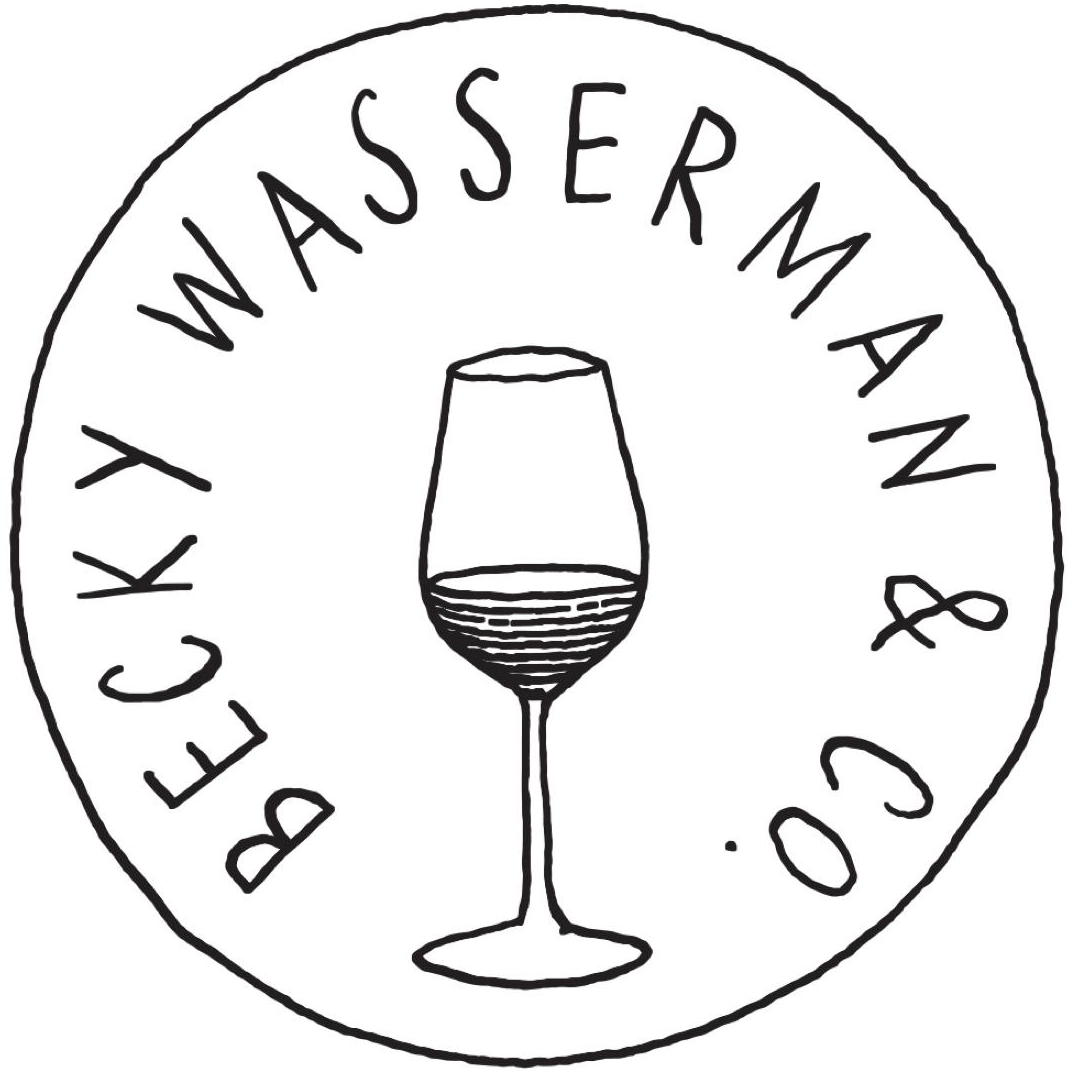Vertical of Deiss’ Altenberg de Bergheim

Altenberg de Bergheim (there is also a grand cru Altenberg de Bergbieten) was the vineyard that set Jean-Michel Deiss down the path of his famous field blends. When he took over the domaine in the 1980s, Jean-Michel vinified Altenberg the way he had received it, as separate cuvées of Riesling, Pinot Gris, and Gewurztraminer. In the 1990s, Michel Bettane, France’s most influential wine reviewer, visited Jean-Michel regularly. The pair were fascinated with Altenberg’s dominance: the terroir was so powerful it eclipsed the grape varieties. So in the cellar one day, they made an Altenberg blend; it was vastly superior to its components. That moment was Jean-Michel’s Eureka: “The production of this wine is a milestone in my life as a wine-grower and marks a break with the variety-over-terroir dominance under which the Alsace region has suffered so greatly for the past 100 years.” Since 2001, after epic efforts on the part of Jean-Michel, the legislation for Altenberg de Bergheim Grand Cru was modified to allow all thirteen Alsatian varieties in its composition instead of being restricted to one only of a shorter list (generally Riesling, Gewurztraminer, and Pinot Gris, sometimes Muscat, and in the case of Zotzenberg only, Sylvaner). Only one other grand cru at the time, Kaefferkopf, was similarly exempt. (Um, yes, Jean-Michel’s other grands crus are also field blends. But that’s for another day.)
Altenberg’s geology is complex. It is located in the sub-Vosgian hills, in the heart of the Ribeauvillé fault zone, where hard limestone and marls of the middle and lower Jurassic period are juxtaposed against Vosges sandstone. These fossil-rich formations form a ferruginous, rocky, nutrient-poor, clay topsoil, where the vines must dive deep to find nutrients. As to the vineyard’s micro-climate, on one hand, its southern exposure and isolated position facing the plain leave it almost overexposed, making it a solar, hot terroir, where botrytis is systematic. On the other hand, its soils are cold, and the grapes ripen late. This push and pull of hot and cold contributes greatly to Altenberg’s complexity and paradoxical nature.
Altenberg combines the honey and apricots of botrytis with the vibrant citrus of limestone into aromatic fireworks —Jean-Michel calls it “baroque.” It is also full and incredibly rewarding on the attack. But then magic happens. As large as Altenberg is upfront, its mid and back palate are a complete contrast: dry, light, fresh, energetic, salty, mineral, zesty, with the profound and long acidities of limestone. It is a bait and switch of the greatest order, a masterly, unexpected twist. One word recurs often chez Deiss to describe it: cathedral.
Altenberg’s proportions and architecture inspire awe, but when you enter it, it is so full of beautiful light, that awe turns to ravishment.
This paradox doesn’t end at one’s feelings for the wine, or the imagery it conjures. Analyses, specifically residual sugar in g/L, fail to explain it. Altenberg is at the same time obviously sweet on the front palate, and evidently bone dry on the back, leaving you to scratch your head at what to call it. In the words of Number 6 in The Prisoner, “I am not a number”; of Jessica Rabbit, “I’m not bad, I’m just drawn that way”; or of Carl Jung, “The statistical method shows the facts in the light of the ideal average but does not give us a picture of their empirical reality.”
At the end of the day, Altenberg is stunning, a tour de force of power and grace. It demonstrates that one needn’t be revisionist in Alsace, and because of fashion, force something to be bone dry that really doesn’t naturally want to be. Jean-Michel’s brilliant farming has drawn enough minerality, acidity, and dry extract from the soil of Altenberg to prove that off-dry and sweet wines can be just as balanced in Alsace, as digestible, food- friendly, energetic, and magical as they are in Germany.
Jean-Michel: “The Altenberg is not one of the greatest terroirs of Alsace, it is one of the greatest terroirs for white wine in the absolute.”

Dryness/Sweetness
A numerical index of sweetness is an imperfect exercise for many reasons, and especially for Altenberg. The first reason is this dichotomy between the front-palate, sweet, and everything that follows, dry. Tasters who tend to place their trust in the front palate will find the wines sweeter, those who tend to favor the back palate, will find the wines drier. (Priorities.) Then, and you may already have noticed this with dosage in champagne, planetary and lunar phases influence how we perceive sweetness and dryness (root days, fruit days, etc.). Other influences include: what you’re eating; what wine you just had; peer pressure to find anything that isn’t bone dry laughable.
In general, Altenberg is between 50 and 85 g/L residual sugar, 5 to 8 g/L total acidity, and 11.5 to 13% alcohol. So the first thing to bear in mind is that these RS numbers are ONLY that of non-trocken Mosel Kabinetts and Spätlesen! On the other hand, that’s not what Altenberg feels like, because of other numerical considerations, such as acidity, because of botrytis, because of dry extract (with yields of 20hl/ha or less, it has a ton of it) and mostly because it’s a Rhine wine (they are weightier).
Though we were tempted for the sake of political correctness to emphasize Altenberg’s back- palate dryness, we have virtuously done the opposite. For our index to be useful to more than just us and the geeks, we put ourselves in the shoes of tasters who favor the front-palate, a sweetest case scenario. We think Altenberg’s is more of a Rheingau Spätlese level, but here, we have made it span the Auslese level, the category that suffers, says Terry Theise, “when one approaches it by demanding it prove its utility. (…) But there are also miracles of beauty and rapture to be found here, and when you find one you couldn’t care less about how you might ‘use’ it, you’re just glad it found you and will catch you when you swoon. (…) The secret, maybe, is to see Auslese not as a BA or TBA that ‘failed’ but instead as a Spätlese that stretched to an even higher height.” (Do go to the Skurnik website and read at least the introduction to Terry Theise’s 2017 German catalog. You’ll feel noticeably happier, richer, and more intelligent.)
The Index
0: Dry: From bone dry to dry but with fruit. A wine with a few grams RS could be part of this category, if the acidity and extract cause one to sense it as dry.
1: Dry-Tender: it’s a literal translation from the poetic French name for this category in the Loire, Sec Tendre. You don’t see it often anymore, but we are sticking to it, and appropriating it for Alsace. It’s a dry wine, sweetness only rounding things out. Some days you may perceive it as ever so slightly sweet, but on most days you’ll think of it as dry but tender. Feinherb is dry-tender, even though the name isn’t.
2: Off-dry: sweetness obvious but in equal parts with acidity and minerality. Think demi-sec Vouvray, non-trocken Kabinett and Spätlese.
3: Sweet: a wine for which sweetness is undeniable, but still with plenty of minerality, acidity, and dry extract. Think Auslese. We’re still a distance from dessert wine.

4: Dessert: noble sweet wines, with at the gate Goldkap Auslese, a barely-dessert wine, moving up to BA, SGN, TBA, etc. It ought to span two numbers, really.
Note: For further precision, we also avail ourselves of decimals, in 0.25 increments.
The Vertical
2013
Index: 3.25 Alcohol: 11.3 % – RS: 62 g/L – Total acidity: 6.15 g/L
There is tangible disappointment from Jean-Michel and Mathieu when they talk of this wine. They are too close to it. The complicated 2013 vintage had been saved at the eve of harvest, and promised to deliver something even greater than the benchmark 2010. But it didn’t. The weather refused to collaborate; it began to rain again at harvest. Even though father and son decided to risk waiting for botrytis to set in, Altenberg 2013 has much less than usual. “People who like tighter wines will love this,” mourns Mathieu.
Oh hell yes! We unequivocally LOVE it! So much so that we pleaded with the Deiss family to alter their original vertical proposal so we could include it. And we know what Mathieu means, but we don’t find it tight —in the context of Altenberg yes, but as a standalone, it is superb. On the nose, gone are the usual deep honeyed aromas. Instead, we find fresh citrus, stone fruit, white flowers, and the coolness of 2013 coming through as fresh mountain air. The usually weighty attack is more buoyant, refreshing, and zesty, with a delicate, streamlined texture. The finish is bright and bursting with energy. This is a joyous, vibrant and nervy example of the Cru, the nerviest we have ever tasted, and it is irresistible. While Altenberg is undeniably a Rhine wine, in 2013, it travelled to the Mosel.
2012
Index: 3.5 Alcohol: 13 % – RS: 49 g/L – Total acidity: 4.9 g/L
This is a full Altenberg, with low RS but plenty of botrytis, and built like a monument. The nose is youthful and tense. There is rich summer fruit —apricot and peach— and the telltale citrus. With air, it goes into finer and finer detail, the citrus morphing from the primary pink grapefruit zest, to the increasingly complex and specific, a tangerine segment, its translucent skin. The palate is giving, almost Labrador puppy-like, but the mid-palate is restrained, balancing the attack out with structure, minerality, and noble bitterness. It is a wine for the ages.
Jean-Michel: “There are colors everywhere, in all directions, and at the same time there is lightness. The Altenberg is an analytical monster —you smell it and wonder how you are going to swallow it— but when you taste it, it’s an evidence.” Mathieu: “It has everything: matter, amplitude, like a cathedral, but at the same time its pillars are lithe, they reach for the sky.”
2010
Index: 3.75 Alcohol: 11.4 % – RS: 87 g/L – Total acidity: 8.2 g/L
OK, it’s not a competition, and we love all of our children, but this one, maybe we love this one just a little more. The nose is atypical. You’ll find the classic grapefruit and honey, but there is also reduction, and it is flinty, funky, and 420ish. Oh the palate! It is so energetic, yet so Zen. Little lightning bolts of acidity on the attack, the mid-palate alternates between extremes of sugar and acid, at the same time, everything is contained in a restrained ball. The evolution is brilliant, the nose becomes pure mineral, while both sweetness and dry minerality simultaneously infuse the finish. The length is incredible, yet discrete. It is built for the very long term, yet it is giving and complex now. It has the highest RS in this vertical, but it also has the highest total acidity. This may explain why on the day we tasted it, we did not note it with an index of 4 or more. You may find it sweeter. We think we will all agree it is brilliant.
Jean-Michel: “Of course, they will tell me that I am subjective, and I will answer that I am in love. It is a wine that explains perhaps better than any other the genius of 2010. It has the power of togetherness, of the symphonic. There is sablé, there is honey, there is crystal. There is matter, there is incredible richness, there is precision, tension, construction, and evolution. And I can’t even say whether it is noble sweet or dry. It’s beyond that. It’s a très grand vin. It’s almost painfully grand.”
2007
Index: 4.25 Alcohol: 12.1 % – RS: 79 g/L – Total acidity: 6.04 g/L
Though it is still fresh, we have definitely entered the universe of the aged. Honey and botrytis but also evolved notes, the grapefruit itself is honeyed, and there are exotic savory aromas, a Thai dish with lemongrass. On the palate, the structure of Altenberg has resolved. The texture is soft, round, and sweet, yet graceful, with acidity now in filigree. The resolution is very, very rewarding. We’re in a place of calm and peace.
2005
Index: 4.25 Alcohol: 11.8 % – RS: 86 g/L – Total acidity: 6.40 g/L
Pure gold color, and even more mature on the nose than the 2007, but in a classy and complex manner, with honey, cream, iodine, salted caramel, and then hints of the funk of maturity, with sous-bois after the rain. The attack is creamy and rich, with sweet spice, and salted caramel too. The acidity is resolved, it comes across as orange peel. There is power, finesse, and harmony. At the same time there is still dry extract in the finish, some dried leaves, and plenty of layers to keep it going for many years. It is very stately and noble. Grand Vin.
2004
Index: 3.5 Alcohol: 11.6 % – RS: 55 g/L – Total acidity: 5.20 g/L
There is some of the 2013 freshness and restraint here. More acidulated notes on the nose, bright aromas of quince, alpine freshness. Ripeness is in the background with the aromas of the ripe pips of grapes and apples. An acid framework follows through on the attack, and there is extract, and delicate notes of green tea and dried leaves. This is a beautifully restrained, pensive and introverted version of the usually friendly Altenberg. Not as stately as 2005, but on the other hand, it has the vibrancy of the cooler vintage.
